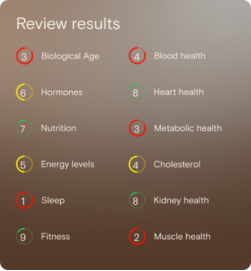What is a Liver Function Test?
A Liver Function Test (LFT) refers to a collection of blood tests that measure enzymes, proteins and other substances linked to the liver’s metabolic and synthetic roles (such as ALT, AST, ALP, albumin, bilirubin). While each individual measurement reflects a slightly different aspect of liver performance, together they tell a story about how well the liver is contributing to your overall energy metabolism, protein synthesis and nutrient handling.
Why does it matter for long-term health and wellbeing?
Your liver acts as a central metabolic hub: it processes nutrients, stores glycogen, produces proteins (like albumin), manages lipids and clears metabolic by-products. If liver function is compromised or sub-optimal, these processes become less efficient and can undermine energy, recovery, metabolic flexibility and ultimately your longevity potential. Monitoring LFTs gives you actionable insight – not to diagnose disease, but to optimise performance and ensure your baseline metabolic infrastructure is in strong shape.
What’s an optimal level of a Liver Function Test?
Typical Australian reference (“normal”) range for ALT (one key enzyme) is about 5–40 U/L for adult males and 5–35 U/L for adult females.
Because “normal” simply means statistically average in healthy populations, for optimal metabolic performance you may aim for the lower end of the normal range. For example, some recent pooled data suggest upper limits of ~32 U/L overall and ~28 U/L for females among metabolically healthy individuals.
Suggested optimal range (for tracking, not diagnosis):
- Reference range low: ~5 U/L
- Reference range high: ~40 U/L (male) / ~35 U/L (female)
- Optimal range low: ~5 U/L (practically minimal value)
- Optimal range high: ~30–32 U/L (male) / ~28–30 U/L (female)
Always use the reference range provided by your pathology lab as the primary guide.
What influences Liver Function Test levels?
Many lifestyle and metabolic factors can influence LFT results:
- Dietary composition (e.g., high fat/sugar intake increases metabolic burden on the liver)
- Alcohol consumption and toxin exposure
- Body composition (higher BMI/waist circumference have been linked with elevated ALT in Australian studies)
- Physical activity levels and muscle mass
- Sleep quality and recovery (affects metabolic stress)
- Medications and supplements (some may increase liver enzyme release)
Monitoring lifestyle trends alongside your LFTs helps you identify which levers you might adjust to support liver-metabolic performance.
What does it mean if a Liver Function Test is outside the optimal range?
If your result sits outside the optimal target zone (for example, elevated ALT above ~30 U/L), it doesn’t mean you have a specific disease – but it does signal that your liver’s metabolic load or stress may be higher than ideal. It becomes an early-warning indicator that there may be room to improve lifestyle factors (nutrition, movement, recovery, toxin exposure) to strengthen your metabolic base. Over time, tracking trends helps you see whether your adjustments are moving you toward a more efficient baseline.
How can I support healthy Liver Function Test levels?
Here are lifestyle-based strategies aligned with a high-performance, longevity-oriented approach:
- Prioritise a whole-food diet rich in vegetables, lean protein and healthy fats to reduce metabolic load on the liver.
- Maintain a healthy body composition (waist circumference, BMI) to reduce metabolic stress on the liver.
- Ensure quality sleep (duration and continuity) to support the liver’s overnight recovery phase.
- Engage in regular movement and resistance training to enhance metabolic flexibility and enzyme efficiency.
- Minimise excessive alcohol or known liver-stress exposures – moderation supports better enzyme maintenance.
- Periodically record your LFTs (as part of your Vively health dashboard) and review how lifestyle changes affect the trend lines.
This information is provided for general health and wellness purposes only and does not replace medical advice.




















.png)
